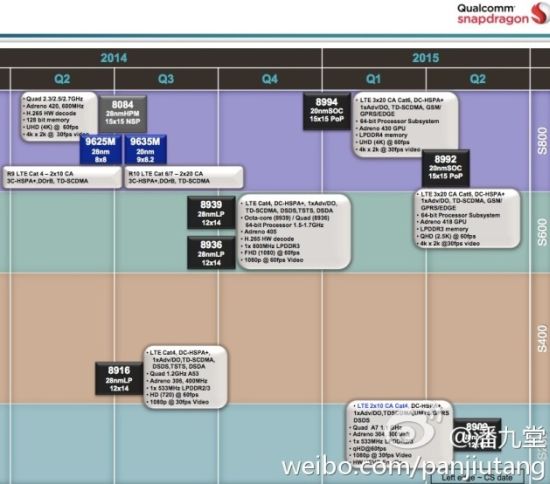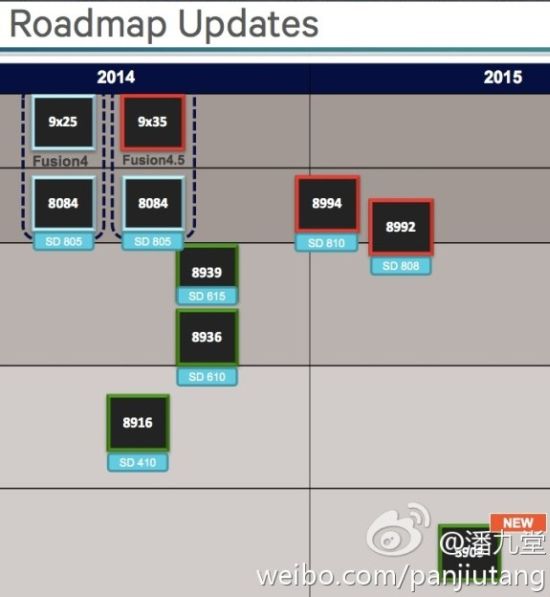Leaked Qualcomm Roadmap Shows Mid-Range and High-End ARMv8 (64-Bit) Chips Will Arrive In 2015
A leaked roadmap confirms that Qualcomm will be sampling its mid-range Snapdragon 610 and Snapdragon 615 ARMv8-based (64-bit) processors later this year. Shipping usually happens about two quarters after the sampling begins, so we should expect them to arrive in devices in Q1 or Q2 2015.
The higher-end ARMv8 chips will be arriving a little later, likely in Q3 or Q4 2015, if the sample date is Q1 or Q2 2015 as shown in the leaked roadmap. We already know that its low-end chip, the Snapdragon 410, will be arriving later this year.
The Snapdragon 610 is a SoC (System on a Chip) formed from an ARM Cortex A53 processor clocked at 1.7 GHz, an Adreno 405 GPU, and other proprietary Qualcomm components such as an integrated LTE modem and a DSP. The chip supports up to 21MP cameras, 1080p at 60fps video recording, and it includes support for the more efficient HEVC codec.
The Snapdragon 615 is similar to the Snapdragon 610, but it comes with a twist. It has eight Cortex A53 cores, with four being clocked at 1.7 GHz, while the other four are clocked at 1.0 GHz. This implies a big.Little setup, but it's the first big.Little set-up that has the same type of cores for both low-end and high-end tasks.
Are four 1.0 GHz cores really better than dynamically scaling back the performance of four 1.7 GHz cores? And is paying for twice as many CPU cores worth the (presumably) slight increase in power efficiency from this setup? Or is this just a move to cater to the Chinese core-hungry market? These are questions that will hopefully get answers when the chips arrive in actual devices.
Then we have Qualcomm's high-end Snapdragon 808 and the Snapdragon 810 chips for next year. Both seem to use the big.Little architecture, with four Cortex A57 cores for high-end tasks and four Cortex A53 cores for low-end tasks, but we don't yet know what their clock speeds will be. Their GPUs are also different, with the Snapdragon 808 using the Adreno 418 and the Snapdragon 810 with an Adreno 430 GPU, which should be (only) 30 percent faster than the upcoming Adreno 420 (inside Snapdragon 805).
Qualcomm seems to have used ARM's own stock cores throughout its entire lineup for late 2014 and 2015, which is surprising given that Qualcomm tends to license the architecture from ARM and then create its own custom CPU core -- much like Apple did with Cyclone and Nvidia did with Denver.
Get Tom's Hardware's best news and in-depth reviews, straight to your inbox.
So far, the chips don't look like they'll be clear winners in 2015, but the final outcome also depends on whether the competition can step up its game, integrate LTE modems into its SoCs, and develop great relationships with OEMs. Otherwise, Qualcomm should remain at the top of the mobile chip market next year, too, regardless of how well its SoCs fare in terms of performance, price, power consumption or other metrics.
Follow us @tomshardware, on Facebook and on Google+.
Lucian Armasu is a Contributing Writer for Tom's Hardware US. He covers software news and the issues surrounding privacy and security.
-
jasonelmore Where are Qualcom's Custom ArmV8 Cores? they hold the IP license to make their own stuff, yet they are using turn key solutions in this entire roadmap.Reply -
dragonsqrrl ReplyWhere are Qualcom's Custom ArmV8 Cores? they hold the IP license to make their own stuff, yet they are using turn key solutions in this entire roadmap.
The story I heard was that Qualcomm decided to scrap their upcoming custom design back around the launch of the A7 and start over pretty much from scratch. Apparently Apple's ARMv8 architecture sort of caught them off guard, along with most of the industry. The rumor floating around was that Qualcomm's next custom architecture, which at the time was already pretty far into development, would ultimately be a lower performing design than the processor in the A7, and to top it off it would still be 32-bit. So I guess Qualcomm decided to just cancel this intermediary architecture, which would be faster than Krait but still 32-bit, and jump straight to 64-bit ARMv8. The last I heard they'll be relying on ARM's Cortex A57/A53 through 2015, with their custom ARMv8 architecture launching sometime in 2016.

